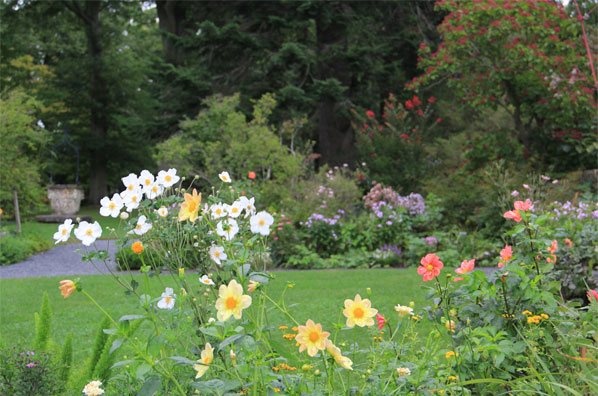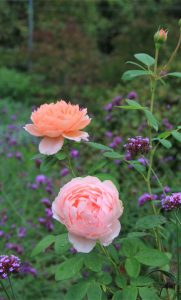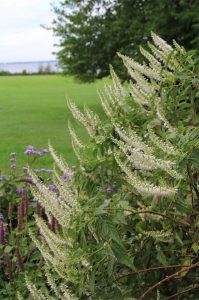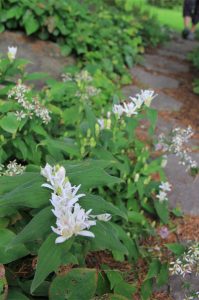Along the Garden Path

Garden Rebound

Rosa ‘Carding Mills’ with Verbena bonariensis
The drenching rain and the cooler temperatures are just what the gardens wanted. Some flowering plants are re-blooming and others are just starting. Many of the late season flowers are triggered to bloom by the shorter day lengths. This is called photoperiodism, where a plant can sense seasonal changes in light to set it into bloom. With these conditions, the flowering plants all seem happy.
In the Rose Garden, although it’s not the fantastic flush of blossoms in the spring, the rose bushes are flowering again. Their presence and fragrance is refreshing. Apricot pink Rosa ‘Carding Mills’ has a whole new look with Verbena bonariensis as a back drop.
In the North Garden, the windflower (Anemone x hybrida ‘Honorine Jobert’ ) has fresh white flowers blooming alongside yellow Dahlia ‘Ryecroft Sunrise’ and salmon Dahlia ‘Giggles’. This type of dahlia is called a collarette -with a collar of inner petals on the flowers. The plants and blooms are graceful and blend nicely in a mixed border.

Chinese mint shrub (Elsholtzia sauntonii ‘Alba’)

Toad lily (Tricyrtis hirta)
Also in the North Garden walking towards the Bosquet is the Chinese mint shrub (Elsholtzia sauntonii ‘Alba’). Many tall spikes of pure white flowers cover this shrub with many bees appreciating its late arrival.
Further along the path into the Rock Garden is another faithful late season bloomer, the toad lily (Tricyrtis hirta). Despite the name, their flowers resemble individual tiny orchids and have happily reseeded along the Rock garden paths.
As I walk back to the greenhouses a stop by the Pollinator Garden reveals lots of bees foraging for nectar and pollen. Mountain mint (Pycnanthemum muticum) constantly amazes me as it has been flowering since July and feeding the bees. A large praying mantis surprises me as it lumbers along the flowers. It’s a great time of year to see the gardens. Come and take it all in.
Featured Image: In the North Garden, white blooms of Anemone ‘Honorine Jobert’, yellow Dahlia ‘Ryecroft Sunrise, and salmon Dahlia ‘Giggles’
Click here to see Gail’s video of a praying mantis.
